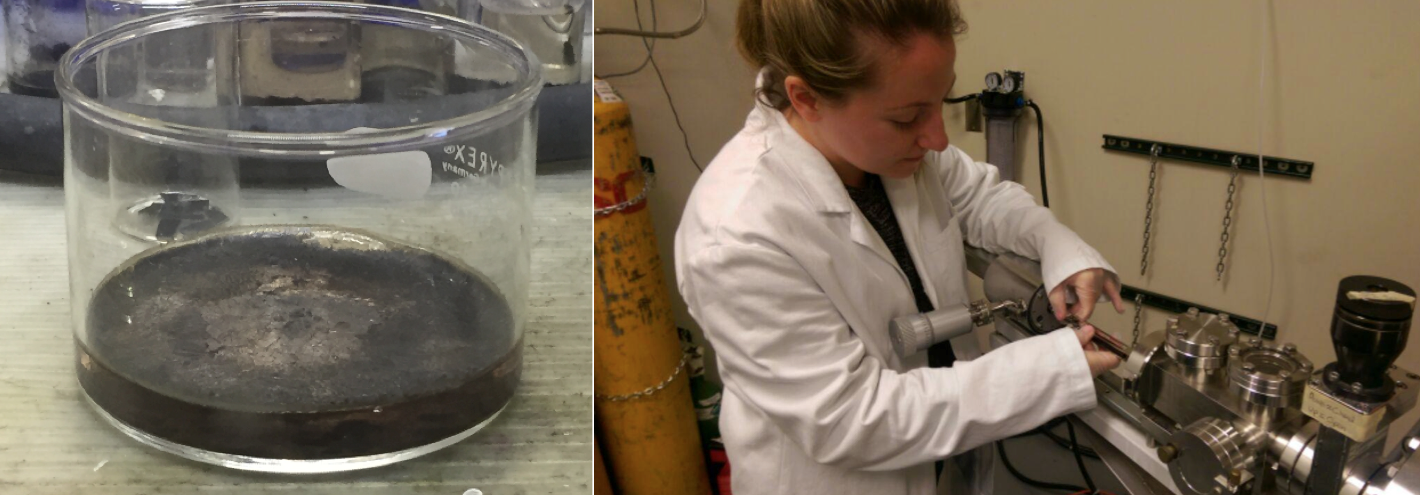By: Courtney Downes
Hello everyone! Courtney, here. I am a Summer WIES Sonosky Fellow, pursing a PhD in chemistry in Dr. Smaranda Marinescu’s lab at the University of Southern California.

Here I am working in the glove-box of our laboratory. Our chemistry is air-sensitive particularly sensitive to oxygen so we have to work inside the glove-box that has a nitrogen atmosphere.
The focus of our research is to develop new catalysts that can help make performing difficult reactions easier. Some of the most important reactions, such as CO2 reduction and water splitting, are challenging and the catalysts that can perform these reactions are typically noble metals so their scarcity and high cost limit their practical application. CO2 reduction and water splitting are very significant reactions in the quest to reduce and/or eliminate the world’s reliance on carbon based fuels and transition to renewable energy sources such as solar and wind. These reactions are usually associated with the process of artificial photosynthesis where raw materials like CO2 and water are converted into desirable fuels such as methanol and hydrogen gas.
My summer as a WIES Sonosky Fellow has been spent synthesizing and characterizing new catalysts for the hydrogen evolution reaction (HER), one half of water splitting. Hydrogen gas has the potential to be an important energy carrier. Most renewable energy sources are intermittent: the sun shines during the day and wind power is difficult to predict. If we use the sun as our major energy source, which sounds like a great idea since sunlight is free and abundant, what happens at night when energy demand is highest? The way to get around the intermittency of renewables is to store them on demand and then use the energy whenever it is needed.

Left: The black film in the dish is the synthesized nickel catalyst Right: I am preparing a sample of our catalysts for study using X-ray Photoelectron Spectroscopy
The ability to efficiently make hydrogen from water where all of the energy needed to drive the reaction comes from the sun would be a great step in combating climate change and moving away from fossil fuels. The sole product upon burning hydrogen is water resulting in a carbon free energy cycle.
Platinum is the state of the art catalyst for solar driven hydrogen production from water. However, platinum is very expensive and its availability is too limited to meet the global energy demands. Therefore, scientists are working tirelessly to develop new catalysts that use only earth-abundant and cheap materials to replace platinum in order to reduce the cost of solar driven water splitting devices in hopes of global deployment of these technologies.

USC ‘special edition’ electrochemistry set-up used to study our catalysts ability to generate H2 from water. The bubbles on the black electrode are hydrogen gas that our catalyst made during the experiment!
I have worked this summer on making catalysts using cobalt, nickel, and iron which are much more abundant and cheaper metals than platinum. The nickel and cobalt systems show great promise as our materials can successfully produce H2 from water with efficiencies ranging from 80-100%. As these are new materials, we have only investigated their ability to make H2 electrochemically. This means that we need to apply electrical energy for the reaction to occur.
The ultimate goal is to have the energy needed for this reaction be supplied by the sun, making the process solar driven. The ability of our catalysts to make H2 from water can easily be seen in the image above as the bubbles of hydrogen gas forming on the surface of the black electrode which has been modified with our catalyst. Future studies will look at using simulated sunlight to drive the catalytic reaction which will bring us one step closer to developing a practical direct solar to fuel converting device!
Courtney is a PhD student in the USC Department of Chemistry, in the lab group of Dr. Smaranda Marinescu. Her research focuses on the capture and H2 storage of solar energy production.
